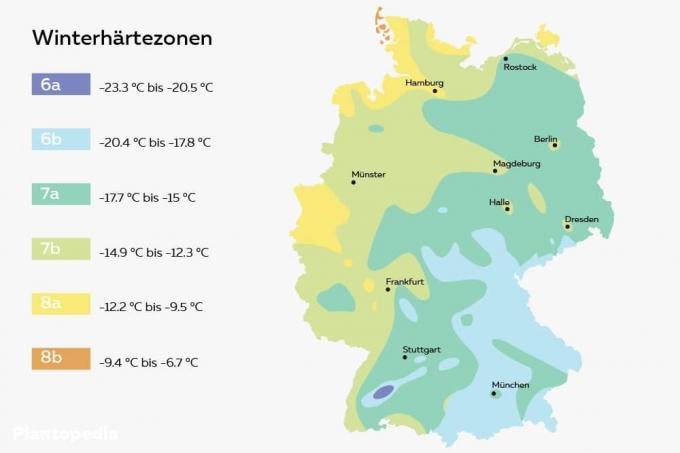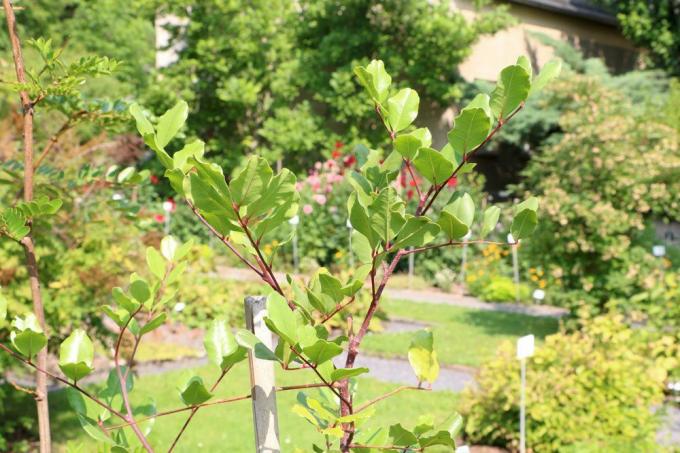
table of contents
- Note winter hardiness zones
- Transfer the planting time
- Roots affect planting time
- Exceptions and Errors
- No spring planting of deciduous trees
- Don't plant conifers too late
- No autumn planting for large trees
When a tree should ideally be planted in the garden depends on various factors. The hardiness zone in your region, the roots of the goods purchased and the type of tree are decisive.
The planting time depends largely on the climatic regions. These are influenced by the geographical location and the altitude above sea level as well as the weather conditions. Germany is divided into hardiness zones, which give you important information about the planting time of the trees:

- Zone 6a (-23.3 to -20.5 degrees): southern Baden-Württemberg
- Zone 6b (-20.4 to -17.8 degrees): Eastern Bavaria, southern Baden-Württemberg and eastern Thuringia
- Zone 7a (-17.7 to -15 degrees): eastern Baden-Württemberg, large parts of Saxony
- Zone 7b (-14.9 to -12.3 degrees): large parts of Germany, deviating occasionally
- Zone 8a (-12.2 to -9.4 degrees): coasts of Lower Saxony and Schleswig-Holstein, Rügen
Transfer the planting time
For each species there are recommendations as to the zone up to which it thrives. Accordingly, you can determine how hardy or frost-prone a tree is. Trees with less winter hardiness should tend to be planted in spring so that they have enough time to develop roots by winter. You can plant frost-resistant species in autumn or on frost-free days in winter.
Note: Trees with less winter hardiness should be protected from frost and direct sunlight in the first winter.
Roots affect planting time
Container plants grow in pots and are offered in this form in garden centers. They are proving to be robust as they were able to develop a complete root system without disturbance or damage. Your planting period is accordingly the widest. Larger trees are gouged out before they are sold so that the root ball is surrounded by soil. A wire mesh ensures that the soil adheres to the root system. They have enough fine roots and grow quickly, so that they will sprout successfully even when planted in late spring in the following growing season. Trees with bare roots are sold without substrate and should be planted directly in the ground without intermediate storage. You first have to develop a network of fine roots, which is why the period of planting is limited compared to root ball trees. This is what the ideal planting times look like:

- Container goods: planting time all year round, except for severe frost periods
- Root ball trees: ideal time in autumn, possible from September to early May
- Bare-root trees: ideal time between October and November, planting possible until the beginning of March
Tip: Bare-rooted trees are cleared in autumn and then stored in cold stores. You should buy and plant such specimens in autumn, because then they are particularly fresh and vital.
Exceptions and Errors
Despite the general recommendations, the timing of planting can vary depending on the species. Important factors that you also have to consider are the leaf shape of the tree and the height of the tree when it is planted out.
No spring planting of deciduous trees
In spring these deciduous trees sprout again. They invest all of their energy in leaf growth so that they can produce sufficient energy through solar radiation in the coming growing season. If you do not plant these species until after winter, root development will suffer. An autumn planting is better, in which the wood concentrates exclusively on the development of a lush root system.
Don't plant conifers too late
This group of trees differs from the related deciduous trees in that they have specialized leaves. Conifers develop greatly reduced leaf areas, which are designed in the form of needles. These are retained in winter and evaporate water all year round. If the tree did not have enough time to grow before winter, the underdeveloped root system cannot maintain the water balance. As a result, the plant dries out. The ideal time to plant conifers is early September.

Note: Early autumn planting doesn't just apply to conifers. Evergreen species also evaporate water from their leaf surfaces in winter and should be planted out in September at the latest.
No autumn planting for large trees
Although larger trees grow well in autumn, you should place specimens more than two meters high in the garden in spring. The reason for this is an increased risk of damage that can occur in winter. Since the root development takes time, the tree does not have sufficient stability in the year of planting. It is exposed to the autumn and winter storms without protection and can tip over despite the use of tree stakes. Freshly set specimens tend to develop tension cracks. These are often caused by temperature differences in winter, because the bark heats up unevenly when exposed to sunlight in the cold season.



